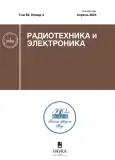Linear prediction coefficients correction method for digital speech processing systems with data compression based on the autoregressive model of a voice signal
- Autores: Savchenko V.V.1, Savchenko L.V.2
-
Afiliações:
- Editorial office of the journal “Radio Engineering and Electronics”
- National Research University Higher School of Economics
- Edição: Volume 69, Nº 4 (2024)
- Páginas: 339-347
- Seção: THEORY AND METHODS OF SIGNAL PROCESSING
- URL: https://rjsvd.com/0033-8494/article/view/650688
- DOI: https://doi.org/10.31857/S0033849424040056
- EDN: https://elibrary.ru/JSCORK
- ID: 650688
Citar
Texto integral
Resumo
The problem of distortion of the autoregressive model of the voice signal under the influence of additive background noise in digital speech processing systems with data compression based on linear prediction is considered. In the frequency domain, these distortions are observed in the weakening of the main formants responsible for the intelligibility of the speaker’s speech. To compensate for formant attenuation, it is proposed to modify the parameters of the autoregressive model (linear prediction coefficients) using the impulse response of a recursive shaping filter. Along with the amplitude amplification of the formants, their frequencies remain unchanged to make the speaker’s voice recognizable. The effectiveness of the method was studied experimentally using specially developed software. Based on the experimental results, conclusions were drawn about a significant increase in the relative level of formants in the power spectrum of the corrected voice signal.
Texto integral
Sobre autores
V. Savchenko
Editorial office of the journal “Radio Engineering and Electronics”
Autor responsável pela correspondência
Email: vvsavchenko@yandex.ru
Rússia, Mokhovaya St., 11, bldg. 7, Moscow, 125009
L. Savchenko
National Research University Higher School of Economics
Email: vvsavchenko@yandex.ru
Rússia, B. Pecherskaya St., 25, Nizhny Novgorod, 603155
Bibliografia
- Rabiner L.R., Schafer R.W. // Foundations and Trends in Signal Processing. 2007. V. 1. № 1–2. P. 1. https://doi.org/10.1561/2000000001
- O’Shaughnessy D. // J. Audio. Speech. Music Processing. 2023. V. 8. https://doi.org/10.1186/s13636-023-00274-x
- Savchenko V.V. // Radioelectron. Commun. Systems. 2021. V. 64. № 11. P. 592. https://doi.org/10.3103/S0735272721110030
- Gibson J. // Information. 2019. V. 10. № 5. 179. https://doi.org/10.3390/info10050179
- Chaouch H., Merazka F., Marthon Ph. // Speech Commun. 2019. V. 108. P. 33. https://doi.org/10.1016/j.specom.2019.02.002.
- Савченко В.В., Савченко Л.В. // Измерит. техника. 2019. № 9. С. 59. https://doi.org/10.32446/0368-1025it.2019-9-59-64
- Candan Ç. // Signal Processing. 2020. V. 166. № 10. Р. 107256. https://doi.org/10.1016/j.sigpro.2019.107256
- Semenov V.Yu. // J. Automation and Inform. Sci. 2019. V. 51. № 2. P. 30. https://doi.org/10.1615/JAutomatInfScien.v51.i2.40
- Marple S.L. Digital Spectral Analysis with Applications. 2-nd ed. Mineola: Dover Publ., 2019.
- Burg J.P. Maximum entropy spectral analysis. PhD Thesis. Stanford Univ., 1975.
- Magi C., Pohjalainen J., Bäckström T., Alku P. // Speech Commun. 2009. V. 51. № 5. P. 401. https://doi.org/10.1016/j.specom.2008.12.005
- Rout J.K., Pradhan G. // Speech Commun. 2022. V. 144. P. 101. https://doi.org/10.1016/j.specom.2022.09.004
- Deng F., Bao Ch. // Speech Commun. 2016. V. 79. P. 30. https://doi.org/10.1016/j.specom.2016.02.006
- Савченко В.В., Савченко А. В. // Измерит. техника. 2020. № 11. С. 65. https://doi.org/10.32446/0368-1025it.2020-11-65-72
- Савченко В.В. // РЭ. 2023. Т. 68. № 2. С. 138. https://doi.org/10.31857/S0033849423020122
- Kathiresan Th., Maurer D., Suter H., Dellwo V. // J. Acoust. Soc. Amer. 2018. V. 143. № 3. P. 1919. https://doi.org/10.1121/1.5036258
- Ngo Th., Kubo R., Akagi M. // Speech Commun. 2021. V. 135. P. 11. https://doi.org/10.1016/j.specom.2021.09.004
- Palaparthi A., Titze I. R. // Speech Commun. 2020. V. 123. P. 98. https://doi.org/10.1016/j.specom.2020.07.003
- Sadasivan J., Seelamantula Ch.S., Muraka N.R. // Speech Commun. 2020. V. 116. P. 12. https://doi.org/10.1016/j.specom.2019.11.001
- Gustafsson Ph.U., Laukka P., Lindholm T. // Speech Commun. 2023. V. 146. P. 82. https://doi.org/10.1016/j.specom.2022.12.001
- Ito M., Ohara K., Ito A., Yano M. // Proc. Interspeech. 2010. V. 2490. https://doi.org/10.21437/Interspeech.2010-669
- Arun-Sankar M.S., Sathidevi P. S. // Heliyon. 2019. V. 5. № 5. Р. e01820. https://doi.org/10.1016/j.heliyon.2019.e01820
- Narendra N.P., Alku P. // Speech Commun. 2019. V. 110. P. 47. https://doi.org/10.1016/j.specom.2019.04.003
- Alku P., Kadiri S.R., Gowda D. // Computer Speech & Language. 2023. V. 81. № 10. Р. 101515. https://doi.org/10.1016/j.csl.2023.101515
- Sadok S., Leglaive S., Girin L. et al. // Speech Commun. 2023. V. 148. P. 53. https://doi.org/10.1016/j.specom.2023.02.005
- Nguyen D.D., Chacon A., Payten Ch.L. et al. // Int. J. Language & Commun. Disorders. 2022. V. 57. № 2. P. 366. https://doi.org/10.1111/1460-6984.12705
Arquivos suplementares


















